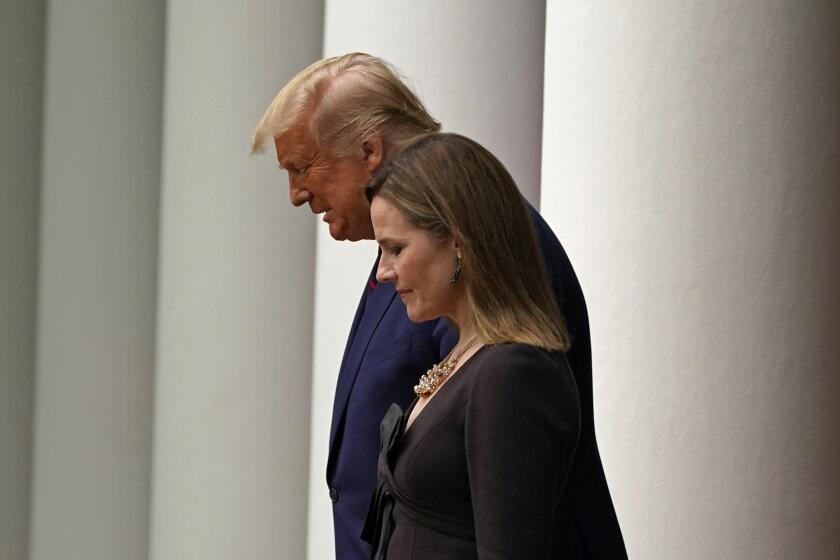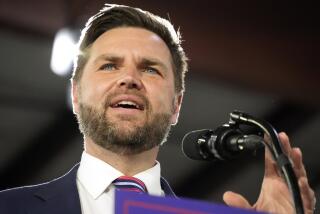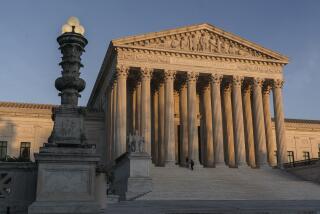Op-Ed: Barrett’s confirmation would seal a Catholic court supermajority. It’s all about timing

- Share via
If the devoutly Catholic Amy Coney Barrett, nominated to the Supreme Court by President Trump, clears the Senate confirmation process as expected, there will be a Catholic supermajority on the court — six out of the nine justices. Two of the remaining three — Stephen G. Breyer and Elena Kagan — are Jewish, and only one, the Trump-appointed Neil M. Gorsuch, is a Protestant (Episcopalian, although he was raised Catholic).
This represents a surprising turn of events: Protestants have historically been the defining religious and cultural majority in the United States, and they still account for a solid plurality of Americans. The composition of the Supreme Court itself was overwhelmingly mainline Protestant for most of its 231-year history, although in the late 19th century presidents began awarding token Jewish and (occasionally) Catholic seats.
For the record:
7:12 p.m. Oct. 24, 2020This op-ed says presidents began awarding token Jewish and Catholic seats on the court in the late 19th century. The first Catholic was appointed in 1836; the first Jewish justice in 1916.
Furthermore, the Catholic supermajority Barrett’s confirmation would establish will be overwhelmingly conservative in both ideology and constitutional outlook.
Five of the tentative six will have been appointed by Republican presidents (Clarence Thomas by George H.W. Bush, Chief Justice John G. Roberts Jr. and Samuel A. Alito Jr. by George W. Bush, Brett M. Kavanaugh and Barrett by Trump). Sonia Sotomayor, appointed by Barack Obama in 2009, is the only Catholic on the court to vote consistently with a liberal bloc that also includes Breyer and Kagan.
The partisan, liberal/conservative aspect of a Catholic supermajority is crucially significant, not least because one of the looming issues before the court is the continuing viability of Roe vs. Wade and a constitutional right to abortion. Legal conservatives think abortion rights have been manufactured out of thin air, and Catholic conservatives think abortion is a grave sin.
How a showstopping Catholic majority took over an erstwhile Protestant institution has to do with the confluence of two trends: the coming of age of Catholics as lawyers and judges just as mainline Protestantism has gone into decline, and the recent politicization of religion, in which Christians, including Catholics, have increasingly aligned their theological and moral beliefs with one side or other of the red-blue divide.
Amy Coney Barrett plus four other dogmatically far-right legal minds could take the court dangerously out of the mainstream of legal thought and society’s needs.
Catholicism, like Judaism, is a religion with a theological tradition primed to produce lawyers. It’s not that Protestants haven’t generated intellectually engaging theology; they have, from John Calvin to Reinhold Niebuhr and Stanley Hauerwas. The difference is that Jews and Catholics have for centuries interpreted their faith legalistically and argued endlessly over fine points: Jews with the Talmud and its commentary, Catholics with the writings of church fathers (such as St. Augustine) and the decrees of popes.
As early as the 12th century the church developed a systematic body of canon law alongside scholastic philosophy, with its emphasis on closely argued distinctions. The result, when Catholics turned their mental energies to secular livelihoods, was “lawyers of the highest quality,” said Adrian Vermeule, a Catholic professor of constitutional law at Harvard. “The pool of excellent lawyers considered for Supreme Court appointments will thus naturally tend to include a disproportionate number of Catholics.”
Anti-Catholicism, however, has been historically baked into Protestantism (simply put, that’s why there was a Reformation). In Protestant-dominated America, Catholics for many years faced social discrimination that tended to bar them from the top-of-the-line legal institutions that led to Supreme Court seats.
Then, starting in the 1960s, large numbers of Protestants drifted away from their churches, and the mainline denominations began losing their membership, their self-confidence and their prestige. The Episcopal Church, once America’s most socially prominent, has lost almost half of the 3.4 million members it had during the 1960s. Catholic parishes emptied out as well, but with less cultural power to begin with, Catholicism’s decline didn’t register in the same way. You might say mainline Protestant hegemony simply vanished from the American scene, its adherents replaced by evangelicals and the unchurched.
Around the same time, American Christianity as a whole became entangled with the partisan political divide, said James Patterson, an associate professor of politics at Ave Maria University in Florida whose research investigates the role popular religious leaders have played in secular politics. In the past, generally conservative figures such as the Rev. Billy Graham and Catholic Bishop Fulton J. Sheen, along with generally liberal figures such as the Rev. Martin Luther King Jr., avoided tying themselves too closely to political parties and their stratagems.
“The church refused to take sides,” said Patterson, in order to maintain its independence from secular control.
That changed, said Patterson, when the evangelical leader Jerry Falwell Sr. placed his Moral Majority starkly behind the Republican Party and its 1980 presidential candidate, Ronald Reagan. Antiabortion politicking (and later “religious liberty”) was the marquee justification for evangelicals’ and Catholics’ overt move to the partisan right.
The alignment is understandable. As the Democratic Party — once a Big Tent stronghold for the working classes, including generations of Catholic immigrants — moves ever closer to an absolutist pro-choice position, it has become officially hostile to those who view abortion as a serious evil. The last Democrat for Life in Congress, Dan Lipinski of Illinois, a Catholic, lost a primary challenge this year to a progressive, Marie Newman.
“The Democrats,” Patterson said, “could be competing for the vote of religiously conservative Catholics, but they don’t, and the Republicans take them for granted.”
Extreme polarization hasn’t been good for America, and it hasn’t been good for American Catholicism, now starkly divided and publicly fighting over theology and politics (as in the furor this week when Pope Francis voiced his support for civil same-sex unions as an alternative to gay marriage). But thanks to luck — and Senate intercession — in the timing of Supreme Court vacancies, Catholic partisanship has recently been very good for Republican presidents seeking smart, capable right-thinking judges.
Out of a large pool of talented Catholic-honed legal minds, GOP White Houses have been able to seat five inclined toward religious, legal and constitutional conservatism. Barrett’s ascension, her undeniable fitness for a seat on the court and its formidable pending supermajority are evidence of a certain kind of Catholic demographic success.
Charlotte Allen holds a doctorate in medieval studies from the Catholic University of America.
More to Read
A cure for the common opinion
Get thought-provoking perspectives with our weekly newsletter.
You may occasionally receive promotional content from the Los Angeles Times.










